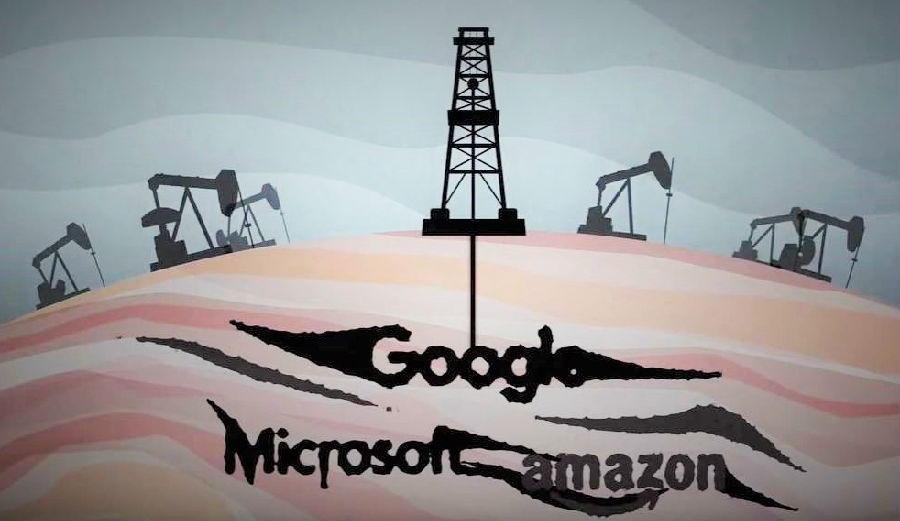On Earth Day 2019, Google posted this video about the "urgency of radically addressing climate change in the next decade."
2019年“地球日”那天,谷歌发布了这段视频,视频主题是“未来十年从根本上解决气候问题的紧迫性”。
This is Kate Brandt, she used to be Obama's chief sustainability officer.
这位是凯特·勃兰特,她曾是奥巴马政府的首席可持续发展官。
Now she works to make Google a global leader in "reducing or even eliminating our dependence on raw materials or fossil fuels."
当下,她正致力于将谷歌打造成全球领导者,“降低乃至消除我们对原材料或者化石燃料的依赖”。
Google's growing data centers need more energy every year.
谷歌的数据中心每年都在扩容,因此对能源的需求也是越来越大。
In 2012 just 34% of that power came from renewables.
2012年,这些能源只有34%来自可再生能源。
But by 2017, they got that up to 100 percent.
但到2017年,这一比例就达到了100%。
They've also managed to lower their total energy use with some help from a branch of artificial intelligence called machine learning.
他们还设法降低了总能耗,而这多亏了“机器学习”(ML)这一人工智能(AI)分支的帮忙。
A computer program takes in lots of data and trains itself to operate the centers as efficiently as possible.
“机器学习”就是一款电脑程序,它能够接收海量数据并自我学习,实现最大限度地提高数据中心的能源效率。
Here's energy use under human supervision, and when the AI is in charge.
这是有人工监管时的能耗,这是AI接管后的能耗。
The more data the AI trains on, the better it gets at reducing energy use.
AI自我学习时能够依托的数据越多,降低能耗的效果就越好。
But here's the thing: this same technology can be used to automate lots of other tasks, like fossil fuel discovery and extraction.
但有一个问题:这项技术还能广泛用于自动化其他任务,比如勘探提取化石燃料。
And while Google is using AI to increase the efficiency of its operation,
而谷歌利用AI提高其能源效率的同时
it's also using it to try and get as much oil and gas out of the ground as possible.
也在试图利用这项技术竭力开采地下的石油和天然气。
In 2018, Google hired Darryl Willis, a veteran of British Petroleum, to lead its new oil, gas, and energy division.
2018年,谷歌聘请了“英国石油”公司的资深人士达里尔·威利斯担任其新组建的石油、天然气和能源部门的带头人。
Willis explained "our plan is to be the partner of choice for the energy industry."
威利斯介绍说:“我们的计划是成为能源行业的首选合作伙伴。”
They've already signed a deal with Total, one of the world's biggest oil companies,
目前,他们已经与国际石油巨头道达尔签署了一份协议,
to develop AI that will streamline oil and gas exploration and production.
一道研发能够简化油气勘探及生产的AI技术。
And Google's not alone.
不止谷歌,
Microsoft and Amazon are also teaming up with the fossil fuel industry.
微软和亚马逊也与化石燃料行业联手了。
Big Tech has entered the oil business.
科技巨头跨界石油圈的时代已然来临。
On June 15, 1957, the citizens of Tulsa, Oklahoma buried a rather odd time capsule, a brand new Plymouth Belvedere.
1957年6月15日,俄克拉荷马州的塔尔萨市民埋下了一个颇为奇怪的时间胶囊——新款普利茅斯“贝尔维迪”。
Sealed inside among commemorative plates, ash trays, t-shirts, and books that captured the spirit of the times, was a 16mm film reel.
和纪念款的盘子、烟灰缸、T恤,书籍等各种能够代表那个时代的东西一起被埋起来的是一卷16mm胶片。
It showed a martian visiting the United States and learning that oil and competition made the nation prosper.
视频讲述的是一名火星人来到了美国,发现是石油和竞争让这个国家逐渐繁荣起来的。
Also included in the capsule were gasoline and motor oil.
除此之外,这个时间胶囊里还放了汽油和机油。
In 1957, it seemed like a very real possibility that these products wouldn't be around in 50 years when the Belvedere was scheduled to be disinterred.
1957年的时候,大家都觉得50年后,也就是按计划该把贝尔维迪挖出来了的时候,埋的那些产品很有可能已经消失了。
Newspapers around the country were reporting that America's oil production would soon fall off.
全国各地的报纸都在报道美国的石油产量很快就会缩水。
And as that cartoon martian learned, discoveries of new reserves were rare.
不仅如此,和上面那个卡通火星人了解到的一样,新探获的石油储量极为有限。
"Only one well in nine finds any oil at all.
“九个油井能有一个探测到油,而且只有一丁点儿的那种都算进来了。

And only one in almost a thousand makes a major discovery.”
就算是有油的井,一千个中间也只有一个能有重大发现。”
Oil has always been really hard to find.
石油一直都很难找。
America's first oil well was drilled in 1859 near a particularly greasy creek in Pennsylvania.
美国是在1859年首次钻探油井的,地点是宾夕法尼亚州一条特别油腻的小溪附近。
It was obvious there was oil seeping up from the ground here,
很明显,这儿有油从地下渗出来,
but it took Edwin Drake over a year and all his money to find a measly little pocket of black gold.
但埃德温·德雷克花了一年多的时间,耗费了他所有的家当才找到了一小块“黑金子”(即石油)。
Still, his discovery triggered an oil boom and a Pennsylvania paper was soon explaining
即便如此,他的发现还是掀起了一股石油热潮,宾夕法尼亚州的一篇文章很快就声称,
that the substance could "illuminate, lubricate, make candles, and cure most diseases from which humanity suffers.”
这种物质可以“照明、润滑、制造蜡烛,还能治愈人类遭受的大多数疾病。”
Not all of that proved true, but 100 years later, petroleum had given the world "fabrics, toothbrushes,
他说的并不全对,但100年后,石油确实给这个世界带来了“织物、牙刷、
tires, insecticide, cosmetics, weed killers, a whole galaxy of things to make a better life on Earth.”
轮胎、杀虫剂、化妆品、除草剂等一大堆能让地球人过上更好的生活的东西。”
And of course, fuel.
当然了,还有燃料。
The energy needs of the world have risen a lot since 1859.
1859年以来,这个世界对能源的需求已经大幅上涨。
And from very early on there were fears that fossil fuels couldn't meet this demand.
然而,一开始就有人担心化石燃料满足不了人们日益增长的需求。
In 1909, some thought oil and gas would run out around 1937.
1909年的时候就有人认为石油和天然气会在1937年左右被耗尽。
In 1937, US oil supplies were supposed to disappear by 1952.
到了1937年,又有人觉得美国的石油供只能撑到1952年。
And so on, and so on, as fossil fuels became more and more essential in every day life, predictions of a crash kept coming.
诸如此类……随着化石燃料在日常生活中变得越来越重要,有关崩盘的预测一直没有停歇。
But somehow, the oil kept flowing.
但不知怎么的,石油竟一直没有断过。
"I couldn't imagine how this ever-increasing supply of oil was achieved.
“我一直难以想象源源不断的石油供应究竟是怎么做到的。
Until I found out that there's not just one but thousands of oil companies
直到我发现,供应石油的石油公司不止一家,而是有成千上万家,
all competing with each other to discover and develop new sources of oil.”
而他们无不在争先恐后地探索开发新的石油来源。”











